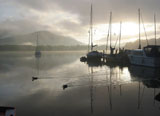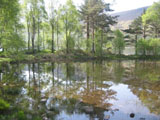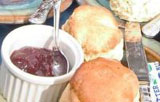|
|
Lake District
Valley and Low-level Walks
Castlerigg Stone Circle to St John's Church - 4 miles
Keswick Stone Circle, usually known as Castlerigg, is reached by taking
the Penrith road out of Keswick, and taking the first branch road, a
narrow one, to the right. At about one mile along this road there is a
branch road right, and just beyond this the entrance to the site.
The Stone Circle is about three thousand years old. Such circles are
sometimes called Druid circles but in fact they were in use long before
the arrival of the Celts and their Druids. Maybe they were places of
worship of some sort; there is some evidence to suggest that they were
also "calendars" so that the earliest settlers here could know when to sow
and when to reap.
Unlike many circles there are no burials within the enclosure which is
slightly pear-shaped. There are now 48 stones, there were probably more
than this at one time. The setting, among the ring of hills, is
impressive. This walk is from here to St John's, a walk across fields
surrounded by hills. It is marred by a few yards of bog, which can be
avoided with patience and care; and a few yards of main road grass verge.
The
tallest stone in the circle is the one on the south-east. Leave the circle
from here and walk ahead to the nearby wall. Go left and downwards with
it. At the end of the wall is the gate, go through this and forward on the
footpath, past a hawthorn tree and going parallel with the wall. Go
through the gate in the corner. Go forward again and right again to an
elbow in the wall. Follow the wall round the elbow to a stone stile. Go
through this and bear right towards a gate. Go through the gate and turn
left. Follow the fence towards the pine wood, and walk alongside the wood,
and at the end of it turn right to follow the hedge and then a wall.
Follow the wall round and go through the gate. Close gate and go through
the farmyard. Go along the road to the right of the house, then instead of
going over the cattle grid go through the large gate to its left. Go
forward keeping the old hedge on your right, then bend left towards the
farm road. Go over cattle grid or through the gate alongside it and join
main road with care. Go left on the grass verge for a few yards and then a
stile in the roadside wall on the left is seen, with a signpost ("Footpath
to Church of St John's in the Vale 1 mile"). Go through the stile and
across the field bearing slightly right, then go through the stile and
down the stone ladder at the other side. The path is clear then alongside
a wall. There is good view of Blencathra to the left. The Helvellyn range
is in front of you. The summit ahead on this range is Great Dodd. The
summit of Helvellyn is at the right-hand end of the range, hidden from
view at this point.
Go through the gate at the bottom, then through the gate and over the
bridge. Immediately afterwards bear left and go towards the corner of the
field. This is a faint path leaving the more substantial track. Avoid
wandering from it, or walking two or more abreast across this valuable
grass crop. A white wicket-gate will be seen. Go through it and across the
bridge, then forward to a wooden ladder-stile. Go over this and follow the
fences round to the right. Cross over the wooden ladder stile on the left
and follow the track. Then instead of following it when it bends left
towards the farmyard, go over the stone stile on the right. Leave the
little sheep-pen which may be beyond the stile and go forward over the
rock outcrops. A faint path will be seen, and over the rock it is worn
smooth. Make towards the right-hand side of the wall in front. A stone
stile can be seen beside an iron footpath sign. Cross the stile onto a
hard-surfaced track. Go across to the signpost (St. John's in the vale
church), turn left up the track, and go along the zig-zags.
The
track brings you to a gate and a kissing-gate. There is a plantation on
the right. Go through the kissing-gate and past the youth centre. The tiny
church of St. John's is just after this. It is only just over a hundred
years old, but it was built on the site of an earlier church. Its setting
is very pretty.
Opposite the church is stone step-stile. Go over this. Go over the little
stream by bearing right, then go forward. The path is faint at first. Some
way
ahead a wall can be seen. The path goes to where the wall dips through a
hollow, and if you look at the objective and walk towards it the path will
then be seen. Blencathra is prominent on the right. Skiddaw ahead. Then there is the very wet ground.
Go well over to the left and making a very wide detour. If you can
keep an eye on the objective of the dip in the wall you should not get
lost. Keep to the right of the big crag. Bog can be distinguished from dry
ground by the moss growing on it, and the lush green grass.
On reaching the wall you will find a stone step-stile. Go over it and
through the hollow ahead. Below to the right is a tarn: Tewet tarn. Make
towards this. The way through the fence is just to the right of the wall.
The large pike on the skyline is Grisedale Pike. Eel Crag is to its left
and before it is the rounded pike of Causey. Go along to the right of the
tarn towards the gate in the wall. Go over the stile alongside it. Go on,
bearing right. The walls to the left and to the right converge ahead. Head
for this and you will find a gate. Go through it and down the field.
(Close this gate.)
Follow the right-hand wall down to the
awkward gate. Join the secondary road and turn left. If you do the walk in
early summer you will enjoy the blue flowers of the native
geranium - Cranesbill, with foxgloves and the blue climbing flower, vetch,
all along the grass verge. This road joins a main road. Turn left and go
along the grass verge. At the bend in the
road take the minor road left signposted "Stone Circle". After this road
crosses a bridge, go through the gate on the left. Go on to the next gate
in the wall. Bear left and head for the next gate. Go through this. The
objective - the prominent farm-house of Goosewell - can be seen ahead. The
right of way probably cannot be seen easily. Head for the farm and you
will reach a small gate. Go through this on to the road and turn left. You
are soon back at the stone circle.
Round Souther Fell - 5 miles
If
you dislike crowds this is probably as good a way as any to get away from
them. It is a circular route from the village of Mungrisdale, going
through a pass on the Blencathra (otherwise known as Saddleback) range.
For a good way it follows the course of the River Glenderamackin, a Celtic
name. Probably Blencathra is another one. Helvellyn is almost certainly
another. There could be various theories about the origin of
Glenderamackin. It sounds very Celtic; but others who favour Norse would
suggest that the Glen part comes from old Norse - Glenna - a clearing in a
forest. In Celtic a similar word means a narrow valley. But this is a long
river eventually running into Derwentwater.
The walk is not for a misty day. Good footwear is essential and there are
wet sections. The beginning of the route is like wandering into a
miniature Scottish highland glen. It follows an apparently ancient track.
So well was the route of this path chosen that a climb is achieved with
the minimum of effort. On emerging from the summit of the pass those with
no heads for heights will worry for a short time perhaps, but the path is
a safe one all the way. The last half of the walk goes gently along a
quiet lane which would be a good example of how the Lake District roads
must have looked at one time before the advent of the internal combustion
engine. Flower spotters should carry their reference books for the last
half of the walk too.
What better starting and ending place than the Mill Inn at Mungrisdale?
Take the Penrith road, the A66, out of Keswick. The Mungrisdale road is on
the left after seven miles, and the village is two miles up this minor
road. Park somewhere safe. The Mill Inn was once a mill. The river falls
below it under an arched bridge making a green and cool scene. Walk on
from the bridge as if you are leaving the inn and the village. Almost
immediately on the left is a lane, with a telephone box at the end of it.
Walk up this lane past the farmyard and through the gates and onto the old
track beyond. Ford a small stream. You are in a green valley surrounded by
softly-shaped fells of Skiddaw slate. Ford another beck - if necessary go
to the right to cross it at a narrower point.
Now don't follow the track to the right, but pick up a track which follows
the river side. The first part of this is very difficult to see as it
crosses wet ground. This can be passed with care and a reasonably clear
path is picked up beyond which gets clearer as you progress. The main
vegetation here is bracken, but in June and July there are foxgloves, and
a white carpet of bedstraw. Cotton grass blows in the wet areas. Muddy
sections can be avoided by going higher to the right when necessary.
Another beck is approached by steppingstones. To cross it turn up right
and there is a. little plank bridge. A grassy path now rises gently. The
next beck crosses the path and tumbles down a waterfall. A place to rest
awhile if you need one for it is a pleasant little scene. If it is not
possible to stride over this beck, take it below to avoid the wetness.
There is soon a bad wet section. If you must avoid it go below it for the
water soaks through the stony ground. Another wet section beyond this can
be avoided in a like manner. You have now reached some height, and if it
was not for the water you can hear tumbling below you could hear a pin
drop. Another wet section (all these wet sections would not be here if the
path had been properly maintained over the years) is best avoided by going
above it, fording a little beck which feeds the bog. Below by the river
side there are now trees, mainly mountain ash, which have grown here
because the river sides are steep and the young trees could not be eaten
by sheep. The river is neared again, and you will presently see a plank
bridge below you. Your way lies across this, but you need not make a
desperate descent to it. Follow the path right past it and you will see
that the correct way zig-zags more gently towards it.
Cross the bridge and follow the path which climbs upwards to the left. On
reaching the path summit look back at the way you have come and be proud
of yourself. Directly behind you is the sharp outline of the Blencathra
summit ridge. You should make out a spur coming off towards you which is
aptly named Sharp Edge. This is one of the routes up the mountain not for
complete novices. You are now, in fact, standing on the side of
Blencathra.
Over the summit you can look down into the green vales of Threlkeld
Common. The fells behind on the skyline are those of Helvellyn. You are
looking at the ridge end on, and the summit is obscured. Over to, the
right if there is clear visibility you might see the pointed summit of
Bowfell, and to the right of this a gap then Scafell Pike. These are well
over fifteen miles away as the crow flies. After going over the summit go
over to the right. The path is at first indistinct over wettish ground but
as you go on it becomes quite clear as it takes the right hand side of the
valley below. Take care over rough sections.
The path descends onto a grassy section. If you look back you will see
again how well the old track makers chose their line for economy and ease
of effort. Go through the gate, close it, and follow the indistinct path
which goes parallel with the fence which is on the left. Go out through
the gate onto the lane. Close gate. Turn left. Go through another gate.
After the first house (Souther Fell) the road has a cobbly surface almost
all the way back to the inn. Geologists will note the characteristics of
the Skiddaw slate in the quarry holes.
More walks:
Part 2 page 14
Part 2 page 13
Page 2 page 2
Page 2 part 3
|
 |



